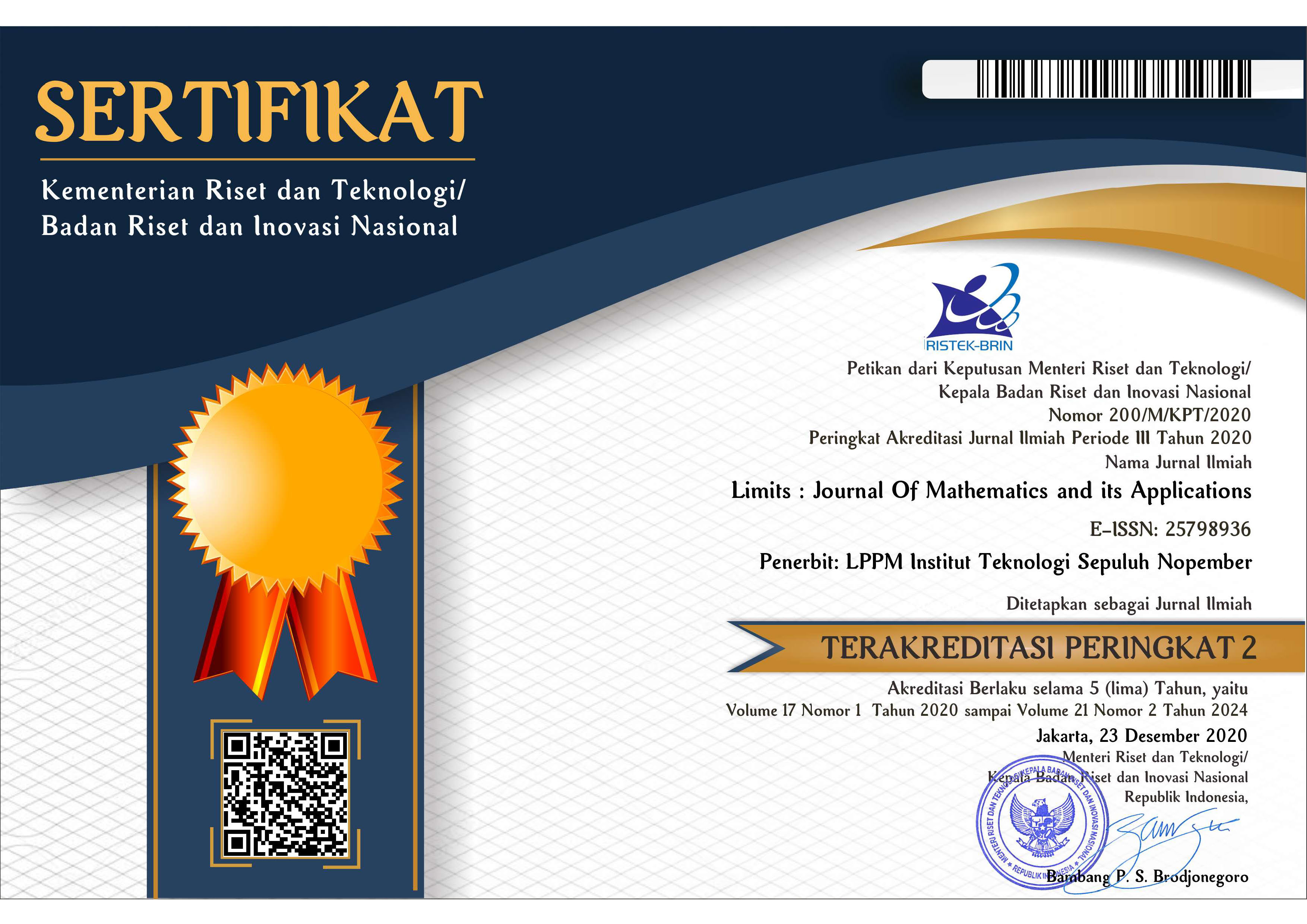Penentuan Effective Reproduction Number COVID-19 dengan Metode Particle Swarm Optimization pada Enam Provinsi di Pulau Jawa
Abstract
Penyakit COVID-19 pertama kali ditemukan di Wuhan, China. COVID-19 menular melalui cairan dari individu yang terinfeksi. Dalam 3 bulan sejak kemunculan pertama, COVID-19 telah menyebar ke 114 negara di dunia. Artinya penyakit ini memiliki tingkat penularan yang tinggi. Oleh karena itu, perlu dilakukan pemodelan untuk mengetahui penyebaran dari virus COVID-19 guna membantu dalam pengambilan kebijakan untuk menangani virus ini. Pada paper ini, model SIRD digunakan untuk memodelkan penyebaran COVID-19 di Indonesia dimana populasi dibagi menjadi empat kompartemen, yaitu Susceptible-Infected-Recovered-Death. Kami melakukan pendekatan stokastik pada model SIRD agar model lebih realistis. Data yang digunakan pada paper ini adalah data COVID-19 pada enam provinsi di Pulau Jawa. Metode Particle Swarm Optimization (PSO) digunakan untuk mengestimasi parameter model SIRD. Selanjutnya hasil estimasi parameter tersebut digunakan untuk menentukan tingkat penyebaran COVID-19 yang direpresentasikan dengan nilai Effective Reproduction Number . Berdasarkan hasil simulasi telah diperoleh nilai real time COVID-19 dari enam provinsi di Pulau Jawa. Nilai tersebut menunjukkan bahwa provinsi yang masih memiliki tingkat penyebaran COVID-19 tinggi adalah provinsi Jawa Barat dan DKI Jakarta. Untuk keempat provinsi yang lain, dapat diketahui bahwa tingkat penyebaran COVID-19 mulai menurun. Hasil estimasi memiliki nilai kesalahan Mean Absolute Percentage Error (MAPE) dibawah 10%, artinya estimasi tersebut memiliki tingkat akurasi yang tinggi.
Keywords
Full Text:
PDFReferences
W. O. Kermack and A. G. McKendrick, “A contribution to the mathematical theory of epidemics,” Proc. R. Soc. london. Ser. A, Contain. Pap. a Math. Phys. character, vol. 115, no. 772, pp. 700–721, 1927.
W. Yang, D. Zhang, L. Peng, C. Zhuge, and L. Hong, “Rational evaluation of various epidemic models based on the COVID-19 data of China,” Epidemics, vol. 37, p. 100501, 2021.
K. Deng and Y. Wu, “Dynamics of a susceptible–infected–susceptible epidemic reaction–diffusion model,” Proc. R. Soc. Edinburgh Sect. A Math., vol. 146A, pp. 929–946, Jul. 2016, doi: 10.1017/S0308210515000864.
Y. Kang and W. Wang, “A stochastic SIRS epidemic model with nonlinear incidence rate,” Appl. Math. Comput., vol. 305, pp. 221–240, Jul. 2017, doi: 10.1016/j.amc.2017.02.003.
M. H. A. Biswas, L. Paiva, and M. do R. De Pinho, “A SEIR Model for Control of Infectious Diseases with Constraints,” Math. Biosci. Eng. MBE, vol. 11, Aug. 2014, doi: 10.3934/mbe.2014.11.761.
G. C. Calafiore, C. Novara, and C. Possieri, “A Time-Varying SIRD Model for the COVID-19 Contagion in Italy,” Annu. Rev. Control, 2020, doi: https://doi.org/10.1016/j.arcontrol.2020.10.005.
S. Putra and Z. K. Mutamar, “Estimation of parameters in the SIR epidemic model using particle swarm optimization,” Am. J. Math. Comput. Model, vol. 4, pp. 83–93, 2019.
A. Hasan et al., “A new estimation method for COVID-19 time-varying reproduction number using active cases,” Sci. Rep., vol. 12, no. 1, p. 6675, 2022.
C. Fraser et al., “Pandemic Potential of a Strain of Influenza A (H1N1): Early Findings,” Science, vol. 324, pp. 1557–1561, May 2009, doi: 10.1126/science.1176062.
H. Susanto et al., How many can you infect? Simple (and naive) methods of estimating the reproduction number. 2020.
M. Bayram, T. Partal, and G. Orucova Buyukoz, “Numerical methods for simulation of stochastic differential equations,” Adv. Differ. Equations, vol. 2018, pp. 1–10, 2018.
J. Kennedy and R. Eberhart, “Particle swarm optimization,” in Proceedings of ICNN’95-international conference on neural networks, 1995, vol. 4, pp. 1942–1948.
X.-S. Yang, Nature-inspired optimization algorithms. Academic Press, 2020.
Q. Bai, “Analysis of particle swarm optimization algorithm,” Comput. Inf. Sci., vol. 3, no. 1, p. 180, 2010.
H. Nishiura and G. Chowell, “The effective reproduction number as a prelude to statistical estimation of time-dependent epidemic trends,” Math. Stat. Estim. approaches Epidemiol., pp. 103–121, 2009.
G. Chowell, H. Nishiura, and L. M. A. Bettencourt, “Comparative estimation of the reproduction number for pandemic influenza from daily case notification data,” J. R. Soc. Interface, vol. 4, no. 12, pp. 155–166, 2007.
S. Makridakis, “Accuracy measures: theoretical and practical concerns,” Int. J. Forecast., vol. 9, no. 4, pp. 527–529, 1993.
R. J. C. Chen, P. Bloomfield, and J. S. Fu, “An evaluation of alternative forecasting methods to recreation visitation,” J. Leis. Res., vol. 35, no. 4, pp. 441–454, 2003.
L. Ren and Y. Glasure, “Applicability of the Revised Mean Absolute Percentage Errors (MAPE) Approach to Some Popular Normal and Non-normal Independent Time Series,” Int. Adv. Econ. Res., vol. 15, no. 4, pp. 409–420, 2009, doi: 10.1007/s11294-009-9233-8.
J. J. M. Moreno, A. P. Pol, A. S. Abad, and B. C. Blasco, “Using the R-MAPE index as a resistant measure of forecast accuracy,” Psicothema, vol. 25, no. 4, pp. 500–506, 2013.
U. Khair, H. Fahmi, S. Al Hakim, and R. Rahim, “Forecasting error calculation with mean absolute deviation and mean absolute percentage error,” in journal of physics: conference series, 2017, vol. 930, no. 1, p. 12002.
C. D. Lewis, “Industrial and business forecasting methods: A practical guide to exponential smoothing and curve fitting,” (No Title), 1982.
DOI: http://dx.doi.org/10.12962%2Flimits.v20i2.8585
Refbacks
- There are currently no refbacks.
Jumlah Kunjungan:

Limits: Journal Mathematics and its Aplications by Pusat Publikasi Ilmiah LPPM Institut Teknologi Sepuluh Nopember is licensed under a Creative Commons Attribution-ShareAlike 4.0 International License.
Based on a work at https://iptek.its.ac.id/index.php/limits.






